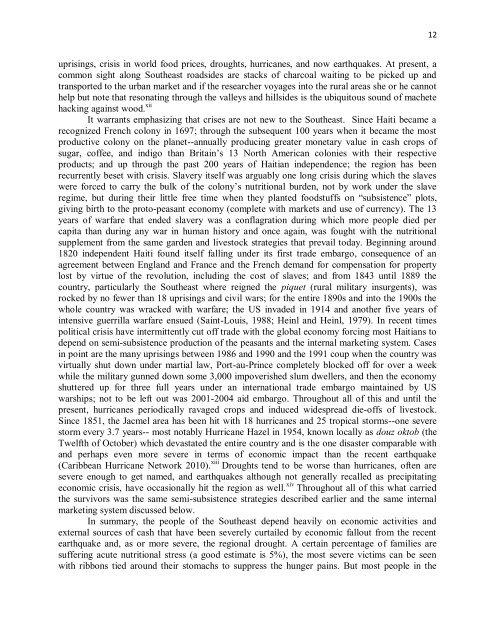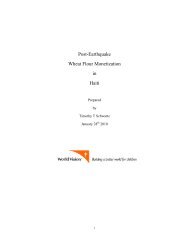Post Earthquake Jacmel (Haiti) Report and EMMA
Create successful ePaper yourself
Turn your PDF publications into a flip-book with our unique Google optimized e-Paper software.
uprisings, crisis in world food prices, droughts, hurricanes, <strong>and</strong> now earthquakes. At present, a<br />
common sight along Southeast roadsides are stacks of charcoal waiting to be picked up <strong>and</strong><br />
transported to the urban market <strong>and</strong> if the researcher voyages into the rural areas she or he cannot<br />
help but note that resonating through the valleys <strong>and</strong> hillsides is the ubiquitous sound of machete<br />
hacking against wood. xii<br />
It warrants emphasizing that crises are not new to the Southeast. Since <strong>Haiti</strong> became a<br />
recognized French colony in 1697; through the subsequent 100 years when it became the most<br />
productive colony on the planet--annually producing greater monetary value in cash crops of<br />
sugar, coffee, <strong>and</strong> indigo than Britain‘s 13 North American colonies with their respective<br />
products; <strong>and</strong> up through the past 200 years of <strong>Haiti</strong>an independence; the region has been<br />
recurrently beset with crisis. Slavery itself was arguably one long crisis during which the slaves<br />
were forced to carry the bulk of the colony‘s nutritional burden, not by work under the slave<br />
regime, but during their little free time when they planted foodstuffs on ―subsistence‖ plots,<br />
giving birth to the proto-peasant economy (complete with markets <strong>and</strong> use of currency). The 13<br />
years of warfare that ended slavery was a conflagration during which more people died per<br />
capita than during any war in human history <strong>and</strong> once again, was fought with the nutritional<br />
supplement from the same garden <strong>and</strong> livestock strategies that prevail today. Beginning around<br />
1820 independent <strong>Haiti</strong> found itself falling under its first trade embargo, consequence of an<br />
agreement between Engl<strong>and</strong> <strong>and</strong> France <strong>and</strong> the French dem<strong>and</strong> for compensation for property<br />
lost by virtue of the revolution, including the cost of slaves; <strong>and</strong> from 1843 until 1889 the<br />
country, particularly the Southeast where reigned the piquet (rural military insurgents), was<br />
rocked by no fewer than 18 uprisings <strong>and</strong> civil wars; for the entire 1890s <strong>and</strong> into the 1900s the<br />
whole country was wracked with warfare; the US invaded in 1914 <strong>and</strong> another five years of<br />
intensive guerrilla warfare ensued (Saint-Louis, 1988; Heinl <strong>and</strong> Heinl, 1979). In recent times<br />
political crisis have intermittently cut off trade with the global economy forcing most <strong>Haiti</strong>ans to<br />
depend on semi-subsistence production of the peasants <strong>and</strong> the internal marketing system. Cases<br />
in point are the many uprisings between 1986 <strong>and</strong> 1990 <strong>and</strong> the 1991 coup when the country was<br />
virtually shut down under martial law, Port-au-Prince completely blocked off for over a week<br />
while the military gunned down some 3,000 impoverished slum dwellers, <strong>and</strong> then the economy<br />
shuttered up for three full years under an international trade embargo maintained by US<br />
warships; not to be left out was 2001-2004 aid embargo. Throughout all of this <strong>and</strong> until the<br />
present, hurricanes periodically ravaged crops <strong>and</strong> induced widespread die-offs of livestock.<br />
Since 1851, the <strong>Jacmel</strong> area has been hit with 18 hurricanes <strong>and</strong> 25 tropical storms--one severe<br />
storm every 3.7 years-- most notably Hurricane Hazel in 1954, known locally as douz oktob (the<br />
Twelfth of October) which devastated the entire country <strong>and</strong> is the one disaster comparable with<br />
<strong>and</strong> perhaps even more severe in terms of economic impact than the recent earthquake<br />
(Caribbean Hurricane Network 2010). xiii Droughts tend to be worse than hurricanes, often are<br />
severe enough to get named, <strong>and</strong> earthquakes although not generally recalled as precipitating<br />
economic crisis, have occasionally hit the region as well. xiv Throughout all of this what carried<br />
the survivors was the same semi-subsistence strategies described earlier <strong>and</strong> the same internal<br />
marketing system discussed below.<br />
In summary, the people of the Southeast depend heavily on economic activities <strong>and</strong><br />
external sources of cash that have been severely curtailed by economic fallout from the recent<br />
earthquake <strong>and</strong>, as or more severe, the regional drought. A certain percentage of families are<br />
suffering acute nutritional stress (a good estimate is 5%), the most severe victims can be seen<br />
with ribbons tied around their stomachs to suppress the hunger pains. But most people in the<br />
12
















